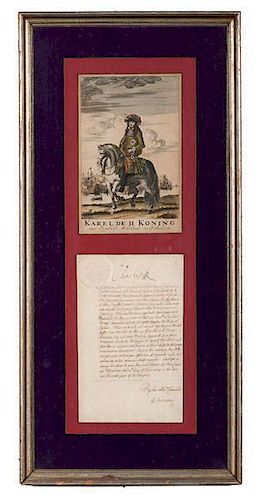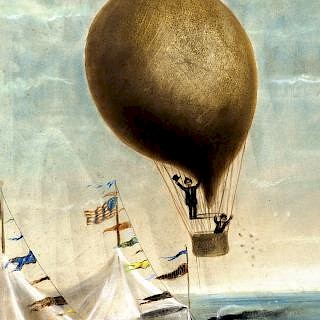Charles II, DS
About Seller
6270 Este Ave.
Cincinnati , OH 45232
United States
With offices in Cincinnati, Cleveland and Denver, Cowan’s holds over 40 auctions each year, with annual sales exceeding $16M. We reach buyers around the globe, and take pride in our reputation for integrity, customer service and great results. A full-service house, Cowan’s Auctions specializes in Am...Read more
Two ways to bid:
- Leave a max absentee bid and the platform will bid on your behalf up to your maximum bid during the live auction.
- Bid live during the auction and your bids will be submitted real-time to the auctioneer.
Bid Increments
| Price | Bid Increment |
|---|---|
| $0 | $25 |
| $500 | $50 |
| $1,000 | $100 |
| $2,000 | $250 |
| $5,000 | $500 |
| $10,000 | $1,000 |
| $20,000 | $2,500 |
| $50,000 | $5,000 |
| $100,000 | $10,000 |
About Auction
Jun 13, 2014 - Jun 14, 2014
Cowan's Auctions dawnie@cowans.com
- Lot Description
1p, 7.25 x 11.5, Whitehall (London), June 27, 1679. Boldly signed Charles R[ex] at top with seal. Order to outfit Sir Henry Goodrick (Knt. and Barott.) (also spelled Goodricke) as Envoy Extraordinary to the King of Spain and his servants with whatever they need to travel to Spain and to represent the King. These are to will and require you to permitt and suffer him the said Sir Henry Goodrick with Three Servants, his, and their Wearing Apparell and other Necessaries freely to Embarque in any of Our Ports, and from thence to passe into France without any let, hindrance or molestation whatsovever. Charles Hamilton's COA and wax seal on back of frame.
After Charles I and his supporters lost the Second English Civil War and Charles was executed for High Treason, Oliver Cromwell established a commonwealth in England. After Cromwell's death (and for numerous sociopolitical reasons), Charles' son, Charles II was declared the lawful monarch to date from his father's death and invited to return from exile on the continent. He entered London on his 30th birthday, May 29, 1660. This document acknowledges this time of exile, by declaring this the one and thirtieth yeare of Our Reigne, which would date of the beginning in 1649.
During his years of exile Charles relied on support of his relatives in France, and his brothers, who had taken refuge in the Hague in the Netherlands. At the time, part of the Low Countries was controlled by Spain (Spanish Netherlands), a valuable ally for the monarch.
Charles II had no legitimate children, but did acknowledge at least a dozen illegitimate ones (although they could not rule, they did influence English history). When he died in 1685 he was succeeded by his brother, James II & VII.
Sir Henry Goodrick(e) (1642-1705) was the first son of Sir John Goodricke, made baronet by Charles I (for which he suffered in the Civil Wars). Sir Henry was appointed on Nov. 28, 1678 as envoy to Madrid. In 1682 he made an offer on behalf of Charles II to mediate between France and Spain, which angered the Spanish court who expelled Goodricke.At present framed and glazed with a hand-colored lithograph of Charles on his horse. Not removed from frame for examination. May be laid down on matting board.Condition
- Shipping Info
-
SHIPPING. At the request of the buyer, Cowan's will authorize the shipment of purchased items. Shipments usually occur within two weeks after payment has been received. Shipment is generally made via UPS Ground service. Unless buyer gives special instructions, the shipping method shall be at the sole discretion of Cowan's Auctions, Inc.. Cowan's is in no way responsible for the acts or omissions of independent handlers, packers or shippers of purchased items or for any loss, damage or delay from the packing or shipping of any property.
-
- Buyer's Premium



 EUR
EUR CAD
CAD AUD
AUD GBP
GBP MXN
MXN HKD
HKD CNY
CNY MYR
MYR SEK
SEK SGD
SGD CHF
CHF THB
THB




